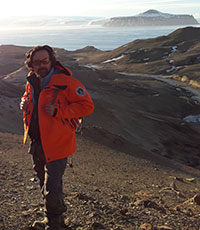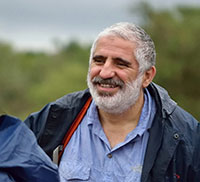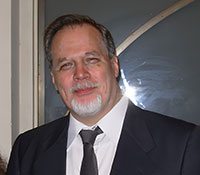 Javier N. Gelfo. División Paleontología de Vertebrados, Museo de La Plata. Paseo del Bosque s/n (B1900FWA) La Plata, Facultad de Ciencias Naturales y Museo, Universidad Nacional de La Plata, Argentina. CONICET, Godoy Cruz 2290, Ciudad Autónoma de Buenos Aires, Argentina. Corresponding author. jgelfo@fcnym.unlp.edu.ar
Javier N. Gelfo. División Paleontología de Vertebrados, Museo de La Plata. Paseo del Bosque s/n (B1900FWA) La Plata, Facultad de Ciencias Naturales y Museo, Universidad Nacional de La Plata, Argentina. CONICET, Godoy Cruz 2290, Ciudad Autónoma de Buenos Aires, Argentina. Corresponding author. jgelfo@fcnym.unlp.edu.ar
Dr. Javier N. Gelfo is a researcher at CONICET and a professor at the Faculty of Natural Sciences and Museum of the National University of La Plata, Argentina, where he teaches Vertebrate Paleontology and Fundamentals of Paleontology. He has worked on various groups of fossil vertebrates, but his main research focus is on the origin, evolution, paleobiogeography, and paleobiology of South American native ungulates and their migration to the Antarctic continent, as well as their biostratigraphic and biochronological significance. The taxonomic groups included in these studies comprise the orders Notoungulata, Litopterna, Astrapotheria, Pyrotheria, Xenungulata, and the formerly known as "Condylarthra". He has published many papers and chapter books on several aspects of these groups and has extensive fieldwork experience in Paleogene and Cretaceous localities of South America and Antarctica.
![]()
 Guillermo M. López. División Paleontología de Vertebrados, Museo de La Plata. Paseo del Bosque s/n (B1900FWA) La Plata, Facultad de Ciencias Naturales y Museo, Universidad Nacional de La Plata, Argentina. glopez@fcnym.unlp.edu.ar
Guillermo M. López. División Paleontología de Vertebrados, Museo de La Plata. Paseo del Bosque s/n (B1900FWA) La Plata, Facultad de Ciencias Naturales y Museo, Universidad Nacional de La Plata, Argentina. glopez@fcnym.unlp.edu.ar
Dr. Guillermo M. López is a teacher and researcher at the Faculty of Natural Sciences and Museum of the National University of La Plata, Argentina. He teaches Zoology III (Vertebrates) and serves as a full professor of Vertebrate Paleontology. He has specialized in the study of fossil mammals, particularly the Paleogene forms of South American native ungulates. His several papers and chapter book contributions include the most comprehensive revision of the Divisaderan Mammal Age at its type locality in Mendoza, Argentina; demonstrating the diachronic origin of the taxa that characterize it and proposing its division into two units: an older one (Divisadero Largo Formation) and a more recent one (Mariño Formation). He has conducted fieldwork in Patagonia, various locations in the Andes Mountains, Northwestern Argentina, and the Antarctic continent.
![]()
 Mariano Bond. División Paleontología de Vertebrados, Museo de La Plata. Paseo del Bosque s/n (B1900FWA) La Plata, Facultad de Ciencias Naturales y Museo, Universidad Nacional de La Plata, Argentina. CONICET, Godoy Cruz 2290, Ciudad Autónoma de Buenos Aires, Argentina. constantino1453@yahoo.com.ar
Mariano Bond. División Paleontología de Vertebrados, Museo de La Plata. Paseo del Bosque s/n (B1900FWA) La Plata, Facultad de Ciencias Naturales y Museo, Universidad Nacional de La Plata, Argentina. CONICET, Godoy Cruz 2290, Ciudad Autónoma de Buenos Aires, Argentina. constantino1453@yahoo.com.ar
Lic. Mariano Bond (retired) has been a researcher at CONICET and a professor at the Faculty of Natural Sciences and Museum of La Plata, National University of La Plata. Over several decades, he has been the main reference for South American native ungulates. He has published many papers and book chapters on this subject. His detailed knowledge of the anatomy and systematics of South American fossil faunas, combined with his prodigious attributes akin to Ireneo Funes, has made him one of the most important specialists in South American paleomastozoology and the history of paleontology in southern latitudes of America.

